The design of the kitchen space implies not only a very careful selection of furniture and interior items, but also thoughtful lighting of all areas of the room. It is here that the exact differentiation of brightness, directivity of the light flux is very important. Modern fixtures for the kitchen are quite diverse in design, can harmoniously fit into the interior with different layouts. But how to understand their features, functionality and design types?
Kitchen sconces and wall-mounted sensory lights, overhead and track shades and models, other design options for home lighting equipment - how do they differ from each other? Do I need to hang a chandelier under the ceiling and how to replace it in a modern interior? These issues have to be addressed by designers and individual homeowners. And the more information there is, the easier it will be to choose the right lighting.




Species overview
Among the kitchen fixtures on the market, you can immediately find several groups of goods that differ in the type of location and direction of the light flux. Depending on the chosen design project in one room may be not one, but several groups of such products.




Ceiling
Kitchen models of lighting fixtures placed on the ceiling can be equipped with shades or have a different type of housing. Built-in lighting options can be mounted directly into the ceiling structure. Among the most popular solutions, there are several options suitable for installation in the interior of the kitchen.According to the type of their design, they are mortise, suspended, laid on and can be fixed on different surfaces - from drywall to ordinary concrete flooring.
Chandeliers
The most common element of the lighting system used to create a common and diffused light flux. Modern models of chandeliers can have either the familiar shape with a pendant mount and one or more shades, or the original, taking up a minimum of space. Above the bar counter and in the dining room area, it is customary to place a row of 3 or 5 devices arranged linearly.
Chandeliers are a pendant type of fixtures, in the kitchen version they are most often equipped with several oppositely directed lamps with closed or half-open shades. In single-tube models, lampshades are used that create more directional diffusion of the light flux. Modern chandeliers are equipped with light intensity controls that allow you to control the lighting power and change it at your discretion.




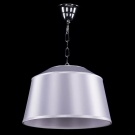

Spotlights and spots
Lighting for the kitchen ceiling can have a built-in and surface-mounted design. Most often in this capacity are spots and spotlights. They are usually mounted in the work area and form a local directional light above the cabinets. The best choice here may be models of appliances that can change direction - in this case, it will be possible to ensure their rational use in both large and small kitchens.
Such lighting can be built into wooden furniture facades, choosing the thinnest LED lamps that do not take up a significant area inside the cabinets. Touch models will be triggered by touching, without spending extra electricity. Options with a motion sensor eliminate the need to click the switch once again.
In the modern version, it can also be halogen, LED or fluorescent lamps, placed in a laid on case and fixed to the ceiling. Such lighting is also considered local, but is suitable for interior decoration in hi-tech style, minimalism and other options where chandeliers are inappropriate. Due to the fact that you can find models of different lengths that can cover even a significant part of the ceiling, these lamps can completely replace the classic pendant ceiling lights.

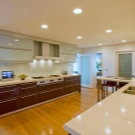




Overhead and mortise panels
Large-sized LED panels can be mounted mortise inside the plasterboard box or installed in the form of overlays. The futuristic appearance of such designs blends well with hi-tech interiors. The panels are very thin and light, give a lot of light, are economical, but are expensive and require proper installation.



Rail pendant lights
This category of kitchen lighting is usually mounted above the dining area or sofa. It is made in the form of sports on a special rail, which is easy to adjust in height.
Such a highlight will look advantageous in a modern interior, but from a practical point of view it is not very profitable.






Wall mounted
Local lighting fixtures most often have a wall mount. Such models do not give diffused light, but they help to zone the space well. They are easy to mount, can be fixed at different heights. But wall lighting can not exist separately from the base.


Sconces
Quite a popular option for local wall lighting. Despite its relevance, sconces with corner or rectilinear fastenings are only suitable for fastening in the dining room or soft corner. If you still decide to use this type of fixtures, it is better to pay attention to mounted models that can easily be moved to a new place in the event of a rearrangement.
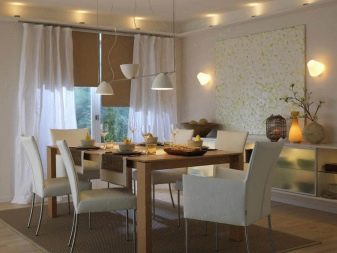
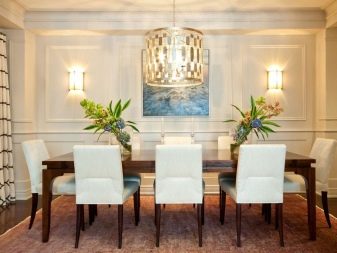


Tubular or light beams
Lamps, widely used as an element of local or decorative lighting design. They easily hide in specially cut niches, look aesthetically pleasing, and are energy efficient. Tubular models are equipped with fluorescent or LED lamps, can be presented in the form of flexible tapes. They are chosen for lighting the working area.


Track lights
The track lights that are not often used in a residential interior radically differ from all other types by the features of their design. The modular system on the guide rail can be linear or closed, the elements on it move freely and change direction. Track lighting systems belong to the category of accenting, allowing to ensure the allocation of specific highlighted areas.
The busbar in this type of equipment may have the following fastening:
- hanging;
- waybill;
- built in.
The modularity of the equipment allows you to easily adjust the kitchen lighting for different tasks - to change the number of fixtures fixed, to group them, turn in the right direction.
The type of lamp used can be halogen, fluorescent, LED, but always energy efficient.




Design options
Lamps for the kitchen may well become a bright and stylish accent in the interior. Moreover, among the existing design options you can really find the right solutions for almost any style of space design. So, in the futuristic interior of a spacious kitchen-living room, fashionable large-format LED panels will look good. They will decorate the interior, help ensure sufficient brightness.
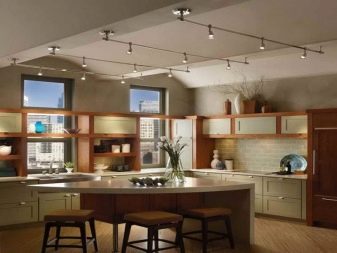


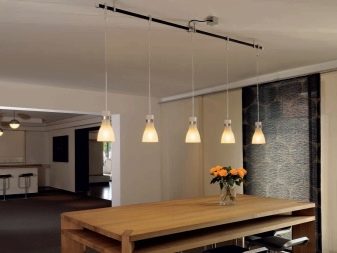
Among the interesting design options for kitchen fixtures, it is definitely worth paying attention to the following relevant solutions.
- Classic wrought iron chandelier with a long suspension. They are mounted lamps, candles, creating the effect of palace luxury. It is important to consider that such a design solution requires a significant area of the room and the height of the ceilings.
Original suspension solutions on chains in combination with solid wooden beams and country-style furniture look especially impressive.
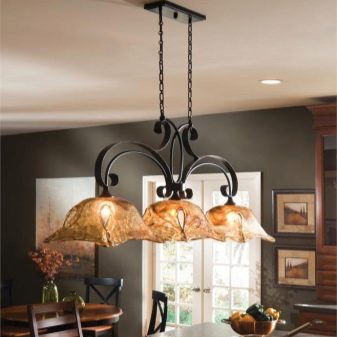

- Bright and stylish cascading chandeliers. They often use iridescent pendants, similar to falling water jets. Do not be afraid of such spectacular models, they harmonize well with modern-style interiors and mirrored ceilings. You can find both compact models and rather massive chandeliers for the dining area.


- Sophisticated geometric patterns. Triangular, polygonal, square fixtures for the kitchen are most often found in the form of sconces or small hanging options arranged in a row. This design solution is combined with minimalistic or high-tech interiors.


- Wicker pendant lights. They are usually placed in a row of 2-3, attached to the ceiling on a suspension, complemented by similar curtains. The spherical shape gives such an unusual ceiling a particularly spectacular appearance. Weaving is made of rattan and is a real fashion hit, harmoniously combined with ethnic styles, loft and eco-friendly direction in design.


- Multi-colored spots with a changing hue of illumination. Remote-controlled systems require professional installation. But it is precisely such overhead or recessed lamps that look especially impressive in the combined space of the kitchen-living room.


- Crystal chandeliers in retro style. They triumphantly returned to fashion and are not going to give their place to other trends. The abundance of pendants, creating a complex play of light, looks ceremonial and solemn.
Such lighting is well suited to the interior of a spacious kitchen-dining room.


- Ceiling chandeliers with floral patterns. Such lamps are mounted directly on the surface of the ceiling, remain a truly stylish decoration of even a small kitchen and give enough soft diffused light.


- Lamps in the modern style. They use the simplest materials - glass, plastic, use unusual shapes and colors. This addition will harmoniously fit into both the vintage and avant-garde interiors.


- Lamps with dark fabric shades. They do not scatter light on the sides, but harmonize well with the dining and dining area. This design solution is in harmony with chrome fixtures, high-tech kitchens or minimalism.


- Bright and light domed chandeliers with metal shades. They are created in order to serve as an unusual accent in the interior. If the kitchen lacks freshness, sometimes just replacing the fixtures is enough.


How to choose?
The selection of devices for lighting the kitchen should take into account their location in the interior, some other features of the product itself and the method of its placement. Among the important points, several can be noted.
- Type of construction. A classic chandelier will be needed to organize general lighting. A modular lamp or spot will provide the necessary lighting in certain areas of the kitchen. It is necessary to take into account the peculiarities of the lamp mount. We can definitely say that getting along with auxiliary backlight just will not work.
- Energy efficiency. The most beneficial are LED lamps, which can be replaced, and non-separable lamps, which, after the LEDs burn out, will have to be sent to the scrap. In addition, fluorescent lighting devices have a high energy efficiency, which have a long service life and spend much less electrical energy. In comparison with them, ordinary incandescent lamps look much less attractive.
- Control method. The time for classic switches, brought out into the corridor or located at the door, is long gone. Modern luminaires are equipped with built-in switches, with the help of which it is easy to provide easy and quick regulation of the intensity of lighting in individual areas. In the working, bar areas, you can install touch models with a motion sensor. They will react to the appearance of a moving object, but if there are animals in the house, the option can lead to an increase in energy costs.
- Type of luminous flux. Basically, this moment is important for LEDs, but when choosing other fixtures, you should pay attention to whether the glow will be warm or cold. Incandescent bulbs give yellow soft light. Cold bluish - halogen lamps, clean daylight provide luminescent backlight options. LED lamps are best chosen with a warm and cold white glow - they are the brightest and most comfortable for the eyes.
- The height of the ceilings in the room. Fixtures for the kitchen in a typical apartment is better not to choose among models with a long suspension. To compensate for the insufficient brightness of the chandelier in a small kitchen, you can use the LED ceiling lights or built-in lamps.
- Feature of the organization of lighting. To form a total luminous flux, devices with diffused or reflected light can be used. For local models with a directional type of backlight are suitable.
- Type of diffuser. This indicator affects the light transmission and safety of using the backlight. The best solution is easy-to-maintain glass scattering elements, completely non-combustible, with high transparency. Plastic products lose their presentability over time, have less light transmission, and are combustible. Paper and fabric diffusers should be used with great care and only in places where long-term burning of lamps is not required.
This criteria for choosing kitchen fixtures is not limited.But other aspects are mainly related to the individual preferences of each owner of the house or apartment
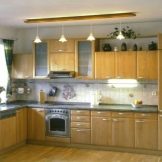


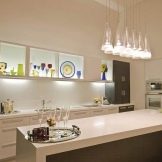
How to post?
Features of the placement of lamps for the kitchen also need to be considered. Depending on the choice of model, these can be designs with different mounts.
- On the wall. As a rule, the height of their placement is selected based on the design features of the headset or soft corner. Corner models are best placed not too high, choosing a sconce with several multidirectional shades.
- Embedded or mortise. Plasterboard or tension base is used for them; ceiling panels made of PVC and MDF can be used. Recessed fixtures can be installed in furniture and podiums, complex elements of multi-level ceilings, bar counters.
- Outboard. They are fixed on special suspensions regulated on height. This category includes chandeliers that decorate the dining area of the kitchen.
- Overhead. Can be mounted on ceilings, walls, furniture. Easy to fix, usually have a built-in switch. Easy to move during repair or relocation in the house.
The right choice and placement of fixtures in the kitchen makes it possible to get a comfortable space for cooking, home gatherings or receiving guests at any time of the day.




The following video will help you find the lighting in your kitchen.










